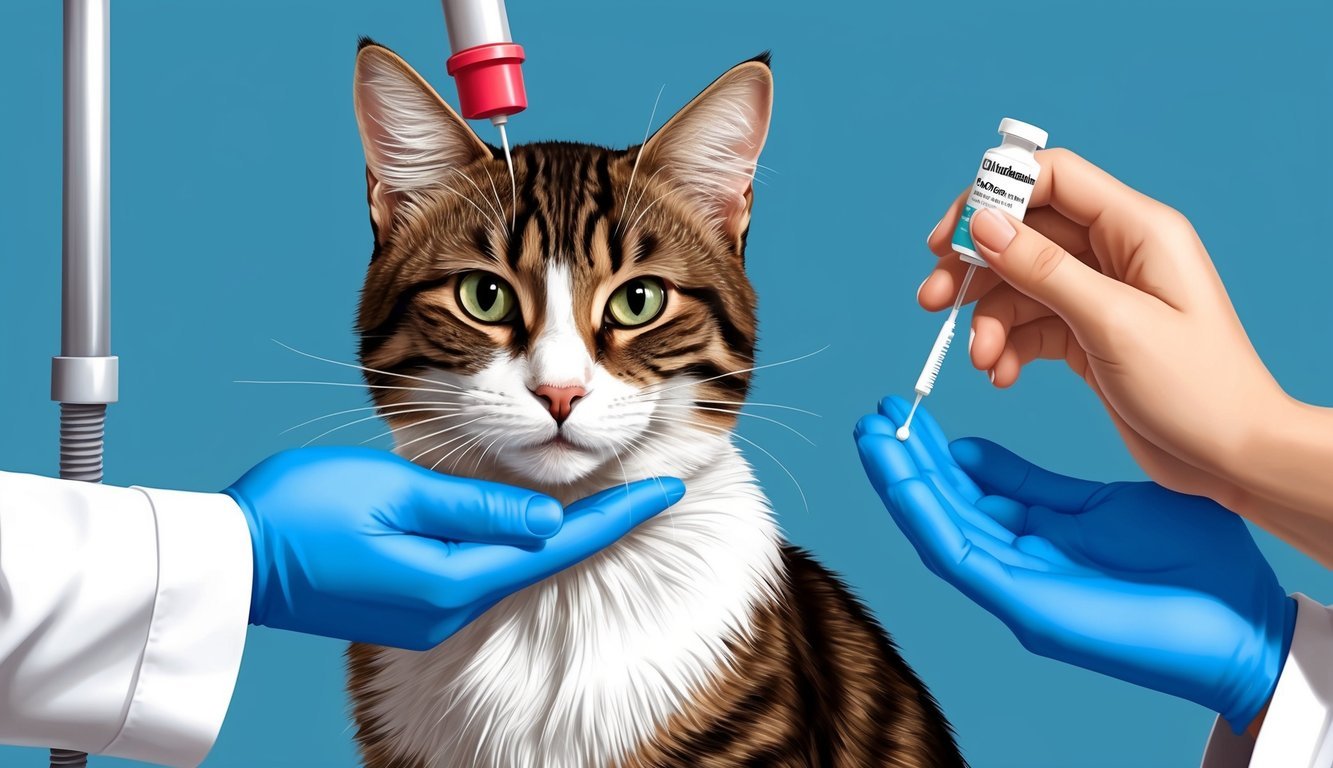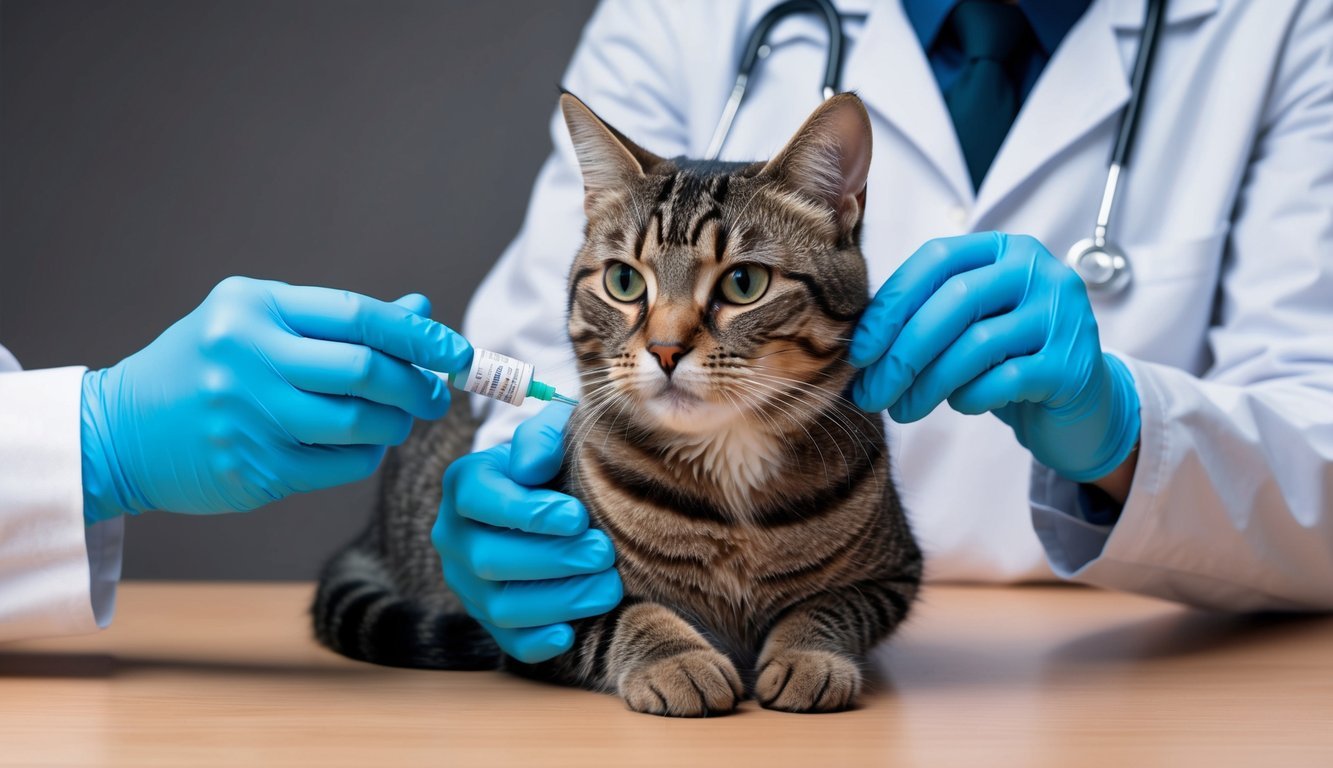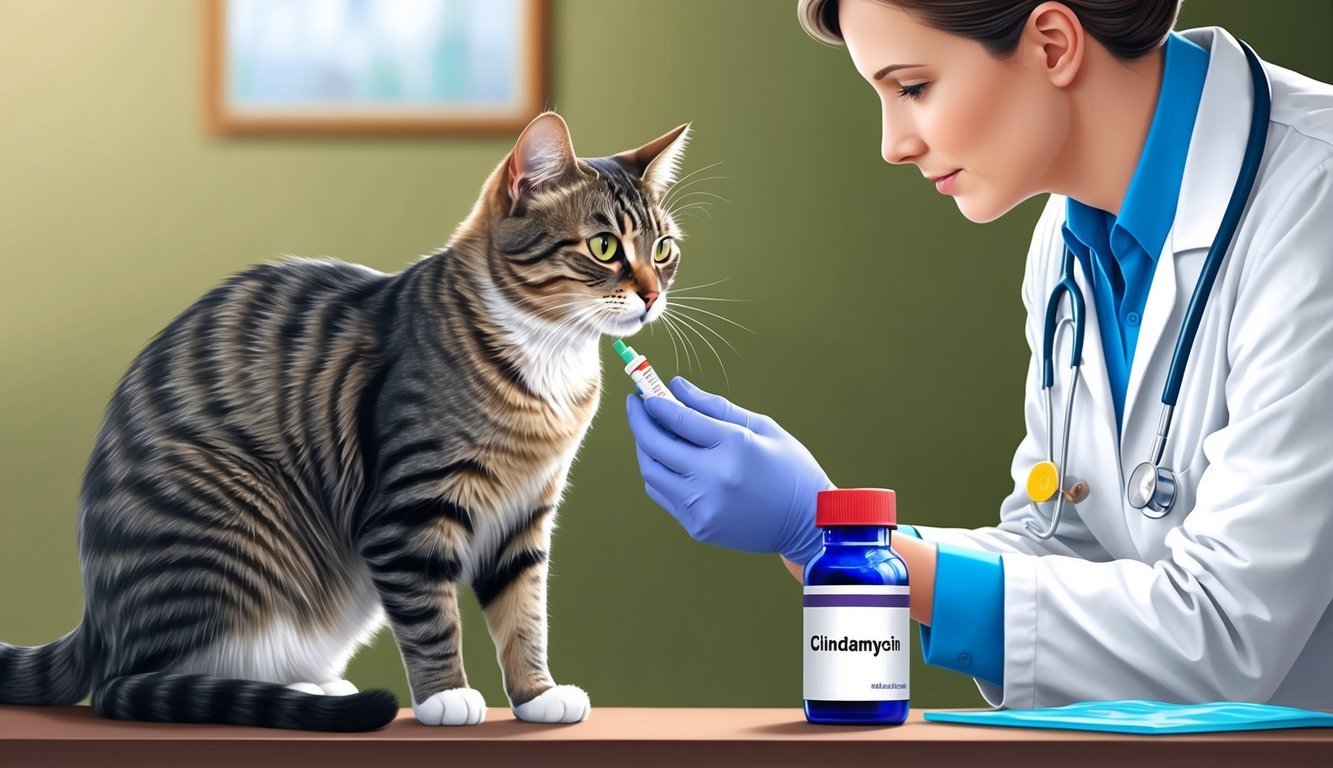Clindamycin is an important antibiotic used in veterinary medicine, particularly for treating various bacterial infections in cats.
If your feline friend is suffering from issues like wounds, abscesses, or dental disease, clindamycin might be an effective treatment option.
Understanding how this medication works and its potential side effects is crucial for any cat owner considering it for their pet.
In this article, you’ll discover the specific uses of clindamycin, how it’s administered, and what you need to watch out for during treatment.
It’s essential to be informed about the precautions necessary for both mothers and their young, as clindamycin can cross the placenta and affect kittens.
Whether you’re looking to treat an infection or simply want to learn more about your options in veterinary care, this guide will provide you with valuable insights into clindamycin for cats.
Key Takeaways
- Clindamycin treats various bacterial infections in cats.
- Awareness of potential side effects is important during treatment.
- Special considerations are necessary for pregnant cats and kittens.
Understanding Clindamycin
Clindamycin is an important antibiotic used in veterinary medicine, especially for treating bacterial infections in cats.
It has specific applications against certain bacteria and is notable for its effectiveness.
Here’s what you need to know.
What Is Clindamycin?
Clindamycin is a lincosamide antibiotic that targets various types of bacteria, particularly anaerobic bacteria, which thrive in low-oxygen environments.
It works by inhibiting bacterial protein synthesis, effectively stopping the growth and reproduction of harmful bacteria.
This antibiotic is often prescribed for infections related to wounds, abscesses, and dental issues in cats.
Clindamycin comes in various forms, such as oral capsules and liquid suspensions, making it easier to administer to your pet.
Brands like Antirobe are commonly used for these purposes.
Clindamycin as an Antibiotic for Cats
This antibiotic is known for its broad spectrum of activity against specific pathogens.
It can combat aerobic bacteria like Staphylococcus and Streptococcus, as well as some strains resistant to other antibiotics, making it a versatile choice for veterinary treatments.
Clindamycin is particularly effective against infections that might be unresponsive to more common antibiotics like amoxicillin.
When your vet prescribes clindamycin, it’s usually for conditions such as dental infections or skin abscesses.
Recognizing the signs of infection, such as swelling, pain, or difficulty eating, can lead to quicker treatment with this antibiotic.
Always consult with your veterinarian to ensure it’s the right choice for your cat’s specific needs.
Comparison with Other Antibiotics
Clindamycin differs from other antibiotics in both its mechanism and its effectiveness against certain bacteria.
For example, while azithromycin is also used to treat bacterial infections, it has a different spectrum of action and may not be as effective against anaerobic bacteria.
Key Differences:
- Mechanism of Action: Clindamycin targets bacterial protein synthesis, while azithromycin affects different pathways.
- Spectrum of Activity: Clindamycin is more effective against Staphylococcus and Streptococcus, especially in anaerobic conditions, compared to many other antibiotics.
When considering clindamycin, understanding these distinctions can help you recognize its importance in treating infections and facilitating recovery in your cat.
Always trust your veterinarian to determine the most suitable antibiotic for your pet’s health.
Clinical Use of Clindamycin in Cats
Clindamycin is an effective antibiotic commonly used in cats to tackle various infections.
From dental issues to skin wounds, understanding its clinical applications can help in ensuring your pet receives the best care possible.
Treating Bacterial Infections
Clindamycin works well against certain bacterial infections in cats.
It’s particularly effective for wounds and abscesses where bacteria can cause significant harm.
By disrupting bacterial protein synthesis, it inhibits the growth of pathogens, aiding your cat’s recovery.
Veterinarians often prescribe it for gram-positive infections such as those caused by staphylococci and streptococci.
If your cat shows signs of infection, such as redness, swelling, or discharge, clindamycin may be part of the treatment plan.
Dental Infections and Oral Health
Dental health is crucial for your cat’s overall well-being, and clindamycin plays a role in addressing dental infections.
Conditions like periodontal disease can lead to serious complications if left untreated.
Clindamycin helps by combating bacteria that contribute to these infections.
Veterinary formulations like Antirobe Aquadrops are specifically designed for cats.
Using it can clear up infections associated with abscessed teeth or severe gingivitis, potentially saving your cat from pain and allowing for better oral health.
Bone and Joint Infections
Bone infections, often referred to as osteomyelitis, can arise from untreated wounds or infections spreading through the bloodstream.
Clindamycin is commonly prescribed to address these deep infections where other antibiotics might fall short.
In cases of joint infections, known as septic arthritis, it may also be used.
Prompt treatment is essential to prevent chronic pain or mobility issues, so if your cat exhibits lameness or swelling around joints, consult your vet about clindamycin.
Skin and Wound Infections
Skin infections in cats are quite common, and they often require careful management.
Clindamycin is effective for treating pyoderma, where the skin becomes infected due to bacteria.
If your cat has wounds from bites or cuts, using clindamycin can help prevent secondary infections.
After administering, monitor the site for any changes, and ensure your cat completes the full course of medication for the best results.
Respiratory Infections
Clindamycin can also be beneficial in tackling certain respiratory infections, especially those caused by anaerobic bacteria.
These infections can sometimes lead to pneumonia in cats, which is serious.
Signs such as coughing, nasal discharge, or difficulty breathing warrant a veterinary visit.
Your vet may consider clindamycin as part of the treatment to reduce inflammation and fight the bacterial agents involved, accelerating your cat’s recovery process.
By being aware of these uses, you can better advocate for your cat’s health and ensure they receive appropriate care when needed.
Administration and Dosage

When using clindamycin for your cat, understanding the correct dosage and administration methods is crucial.
Proper use helps ensure the medication is effective while minimizing potential side effects.
Let’s dive into the specifics.
Recommended Dosage of Clindamycin for Cats
The typical dosage range for clindamycin in cats is between 2.5 mg to 10 mg per pound of body weight.
The most common administration schedule is every 12 hours.
In some cases, your veterinarian may suggest a once-daily dose for less severe infections.
For more severe infections, the dosage might be increased, but only with your veterinarian’s approval.
It’s vital to follow their advice closely.
Here’s a quick reference for dosage based on your cat’s weight:
| Cat’s Weight (lbs) | Dosage Range (mg) |
|---|---|
| 5 | 12.5 – 50 |
| 10 | 25 – 100 |
| 15 | 37.5 – 150 |
Forms of Clindamycin Available
Clindamycin for cats comes in several forms, making it easier to find one that your cat will accept.
The primary forms include:
- Capsules: Available in 25 mg, 75 mg, and 150 mg. These are ideal for cats that can swallow pills without issue.
- Tablets: Similar to capsules but may be easier to split if lower dosages are needed.
- Oral liquid: Commonly known as Antirobe Aquadrops, available in 25 mg/ml concentrations. This is often easier for administering to uncooperative cats.
Always check with your veterinarian to determine the best form based on your cat’s health needs.
Correct Administration Techniques
Administering clindamycin properly ensures that your cat receives the full benefit of the medication.
Here are some techniques:
-
With Food: Always give the medication with a full meal to reduce the risk of stomach upset.
-
For Capsules/Tablets: If your cat resists taking pills, you can use a pill pocket or try hiding it in a small amount of your cat’s favorite food.
-
For Oral Liquid: Use a syringe for accurate dosing. Place the syringe in the side of your cat’s mouth and administer slowly to avoid choking.
-
Monitor Your Cat: Regularly check for any side effects, such as vomiting or diarrhea, and report these to your veterinarian immediately.
Proper administration and monitoring can significantly improve your cat’s experience with clindamycin, ensuring a smoother recovery process.
Potential Side Effects and Reactions

When giving clindamycin to your cat, it’s important to be aware of potential side effects and how to manage them effectively.
This section focuses on the common side effects, strategies for handling gastrointestinal upset, and recognizing signs of more serious reactions.
Common Side Effects in Cats
Clindamycin can lead to several side effects.
The most common include:
- Diarrhea: This can vary from mild to severe. Watch for increased frequency or watery stools.
- Vomiting: Some cats may experience nausea resulting in vomiting.
- Drooling: Excessive drooling might occur as a response to the medication.
If your cat shows any of these signs, it is essential to consult with your veterinarian.
They might suggest adjusting the dosage or considering an alternative medication.
Monitoring your cat’s behavior closely can help catch any issues early.
Managing Gastrointestinal Upset
Gastrointestinal upset is a frequent side effect of clindamycin.
Here are some steps you can take to manage it:
-
Dietary Adjustments: Consider feeding your cat a bland diet, such as boiled chicken or plain rice, until symptoms improve.
-
Hydration: Ensure your cat stays hydrated. Fresh water should always be available.
-
Consult Your Vet: If diarrhea or vomiting persists for more than a day, contact your veterinarian for advice. They might suggest probiotics or dietary changes to ease your cat’s discomfort.
Pay attention to your cat’s fecal matter to monitor the severity.
Report any changes in color or consistency to your veterinarian.
Recognizing Signs of Overdose and Allergic Reactions
In rare cases, your cat may experience an overdose or allergic reaction to clindamycin.
It’s crucial to watch for signs like:
- Loss of Appetite: If your cat refuses food or water, it could be a red flag.
- Lethargy: Unusual tiredness can indicate a problem.
- Severe Diarrhea or Vomiting: If these symptoms are watery or contain blood, seek immediate veterinary care.
- Drooling or Swelling: Excessive drooling or facial swelling can indicate an allergic reaction.
If you suspect an overdose or allergic reaction, do not delay in contacting your veterinarian.
Quick action can make a significant difference.
Special Considerations and Precautions

When treating your cat with clindamycin, it’s essential to acknowledge specific considerations and precautions.
This involves ensuring proper medication usage and monitoring potential side effects or interactions with other drugs.
Precautionary Measures in Treating Cats
Before administering clindamycin, consult with your veterinarian.
They will provide guidance tailored to your cat’s health status and needs.
If your cat is pregnant or nursing, exercise caution since clindamycin can cross the placenta and enter breast milk.
The potential effects on kittens include gastrointestinal issues like diarrhea.
Always discuss any concerns with your vet first.
Dosage Guidelines:
- Typical dosage ranges from 2.5 mg to 10 mg per pound.
- Administer every 12 to 24 hours.
- Always give with a full meal to minimize stomach upset.
Interactions with Other Medications
Several medications can interact with clindamycin, leading to reduced efficacy or increased side effects.
Inform your veterinarian about all other medications your cat is taking.
For instance, combining clindamycin with other antibiotics like azithromycin or cephalexin may not be advisable.
Always follow your veterinarian’s recommendations about dosage and any adjustments.
Common Medications to Monitor For Interactions:
- Antacids: Can decrease clindamycin’s effectiveness.
- Other Antibiotics: May result in increased toxicity or decreased effectiveness.
Monitoring and Adjusting Dosage
Regular monitoring is crucial once clindamycin treatment begins.
Observe your cat for any unusual behavior or symptoms such as vomiting or diarrhea.
If you notice any severe reactions, contact your veterinarian immediately.
They may recommend adjusting the dosage or switching to alternative medications like Antirobe or Cleocin.
Key Signs to Monitor:
- Changes in appetite or behavior.
- Signs of gastrointestinal distress.
Your vet may suggest follow-up visits to assess your cat’s response to treatment and make necessary adjustments.
Comparative Insights

When considering clindamycin for cats, it’s essential to examine its unique properties, effectiveness in treating specific conditions, and advantages over other medications.
This can help you make informed decisions about your cat’s health.
How Clindamycin Stands Out
Clindamycin is a lincosamide antibiotic that targets gram-positive bacteria.
It’s particularly noted for its effectiveness in tackling various infections, including dental issues and skin abscesses.
Unlike some antibiotics that primarily fight certain bacteria, clindamycin acts against anaerobic bacteria which thrive in certain conditions, such as those found in infected wounds.
Its anti-inflammatory properties are another highlight, helping to reduce swelling associated with infections.
This dual action of combating bacteria while alleviating inflammation makes clindamycin a valuable choice, especially for managing complex infections or post-surgical wounds in your cat.
Effectiveness in Treating Toxoplasmosis
Toxoplasmosis is a significant concern for many cat owners, as it can cause severe health issues.
Clindamycin is often prescribed for this condition due to its ability to inhibit the growth of the Toxoplasma gondii parasite.
Research indicates that this antibiotic can effectively reduce the severity of symptoms and aid in faster recovery.
Administering clindamycin for toxoplasmosis requires careful dosage, as your veterinarian will tailor it to your cat’s specific needs.
Regular monitoring during treatment is essential to ensure your cat responds well and to manage any potential side effects.
Benefits Over Alternative Treatments
While there are various antibiotics available, clindamycin has distinct advantages.
For instance, when compared to alternatives like azithromycin or cephalexin, clindamycin often poses fewer gastrointestinal side effects.
This is significant, as antibiotic-associated diarrhea can be common with some medications.
Additionally, clindamycin’s efficacy against anaerobic bacteria makes it particularly beneficial for dental infections or abscesses, conditions where other antibiotics may fall short.
Its ability to cross the blood-milk barrier also allows for use in nursing cats, albeit with caution.
These factors can make clindamycin a go-to choice for many feline infections, ensuring effective treatment while minimizing disruptions to your cat’s digestive health.
Frequently Asked Questions
When considering clindamycin for your cat, you may have several questions regarding its usage, dosage, and effectiveness.
Here are answers to some of the most common inquiries pet owners have.
What is the proper dosage of clindamycin for cats?
The typical dosage recommended by veterinarians is between 5 to 10 mg per pound of your cat’s body weight every 24 hours.
Your vet will tailor this dosage based on the specific condition being treated and may adjust it as necessary.
What are the common side effects when treating cats with clindamycin?
Clindamycin can cause side effects in some cats.
Common reactions include vomiting, diarrhea, and loss of appetite.
It’s vital to monitor your cat for any adverse effects and consult your veterinarian if you notice anything unusual.
What’s the best way to administer clindamycin to a feline?
Clindamycin is available in different forms, including capsules and liquid formulations.
For liquid options, using a dropper can make administration easier.
If using capsules, you can hide them in a small treat to help your cat ingest the medication.
How long does it typically take for clindamycin to show results in feline treatments?
You may start to see improvements within a few days of starting clindamycin treatment.
The exact timeframe can depend on the type and severity of the infection, so keep in touch with your veterinarian for progress updates.
Can clindamycin be used for a variety of infections in cats?
Yes, clindamycin is effective against various types of infections in cats, including skin, respiratory, dental, and reproductive system infections.
Always consult with your veterinarian to confirm it’s the right choice for your cat’s specific situation.
Should clindamycin for feline use be stored in a refrigerator?
Clindamycin does not typically require refrigeration unless specified by the manufacturer.
Store it in a cool, dry place, away from direct sunlight, to maintain its effectiveness.
Always check the product label for any specific storage instructions.

